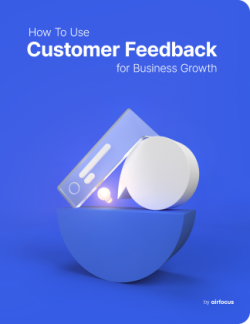The way customers research, use, and buy products or services is changing. Therefore, the way companies attract customers, position their products or service, and sell is evolving.
The internet and changes in consumption patterns mean companies cannot offer average products and services or average customer experiences anymore. Customers have many choices for how they spend their time and money.
Customers are ever more empowered than before.
We often hear phrases like “talk to your users”, “listen to your customers”, and “be the voice of the user”. These are all useful phrases to an extent, however, what does it all really mean?
To level-set expectations, I am not saying you should build everything every customer says. No, that would potentially be a misdirection of resources.
Without customers you might have a product or service, unfortunately, you do not have a business. The goal in my opinion is to build products (and/ or services) that customers want to use and buy.

Also please note the distinction between a customer and a consumer (user.) A customer is one who generally makes the purchase. A consumer is generally the person that uses the product or service.
Of course, a customer can also be a consumer or user. For example, I pay for and use Netflix, Starbucks, and Evernote.
In my day job, I am a user of Office 365 daily, however, my employer is the customer of Microsoft’s Office 365 suite, not me. I don’t have access to the pricing, and billing. My employer is responsible for such items. I have access to support options in the event I experience issues.
In this blog post, I plan to explore what customer centricity is and how to start bringing customer-centric thinking into your business.
What is a customer centric strategy?
According to Gartner “Customer-centric organizations understand the unique problems and expectations and needs of their customers as well as the context of those needs. They then consistently deliver products and services that meet those expectations.”
Amazon founder Jeff Bezos is famously known for his customer focus and once said “Start with the customer and work backward”.
Amazon (in the beginning) was known to reserve a seat for the customer at every meeting. This gets the team thinking about the customers' perspective in the decision-making process.
The reality of business is that regardless of whether your organization is product-led, sales-led, or anything in between, many decisions are made with the product or business in mind.
For example, requiring customers to call a phone number to cancel a subscription. The intent here is simple, once the customer is on the phone, the representative can entice the customer with retention deals. It’s in the best interest of the company, not the customer. In fact, it’s creating extra (unnecessary) work for the customer.

A customer-centric strategy is one where the company takes actions, creates policies & processes, and allocates resources to understand the challenges of their customers, their jobs to be done, the context in which they work, and what success looks like to them. Keeping the customers’ need in mind to create products and services that meet and exceed their challenges, making them successful.
Success is indeed relative. However, your product or service helps create a better version of the customer.
For example, I am terrible at designing.
Since I started using Canva I feel more empowered with my ability to create more designs/ decks etc. Canva didn’t create better software, Canva helped me become better (successful) with my design skills. Therefore, I feel successful when I make presentations using Canva.
Three signs your company is not customer-centric
Decisions are made without customer insight as a data point.
Customers are not loyal, churning, or not willing to share referrals.
Getting new customers is difficult and your competition is gaining market share.
Without a customer-centric strategy, your business is at risk.
How do you create customer centricity and why it’s important
In my opinion, creating customer centricity starts at the top with leadership and getting the right mindset with each team member.
It goes back to creating a culture in which the decision-making process includes understanding the customers’ perspective.
However, becoming customer centric is difficult and requires time and energy.
First, allow product managers to think like customers. Encourage them to talk with customers, users, and prospects on a regular basis to get real-time insights.
Second, share customer insights regularly with everyone in your company. Use these insights as a data point to make better-informed decisions.
Thirdly, encourage the first and second steps until everyone in the company feels comfortable talking to customers and sharing insights.
If as a product manager your leadership team is not encouraging you to talk with customers, users, and prospects on a regular basis, in my opinion, that is a big red flag for your company and potentially leadership not understanding the role of product management.
If you hear phrases like “we don’t want to bother the customer, they are paying and have no issues” I’d consider running in the opposite direction. No seriously, at least have a conversation about why the company thinks like that and then consider running in the opposite direction.
Do you feel empowered to think like the customer?
Generally, companies look at the customer to understand their needs while trying to sell to them. Whereas customer-centric companies think like customers.
For example, let’s say that your sales team is getting ready to pitch your product or service to a major existing customer to grow the account.
In a customer-focused organization, the sales team might look at user personas, and position the product or service as a valuable benefit.
In a customer-centric company, before talking about any new business the sales team reviews any open support, contractual issues, or any open issues with the customer.
The sales team understands that from a customer perspective if a user from the customer's company has raised multiple support tickets because they are unable to use the product's particular feature. Think about what possible steps could be taken to resolve the issues they have first.
Smart customer-centric teams know to seek out ideal customers, talk to them and co-create expansion opportunities together using consultative selling techniques not pitching because the sales team feels they would be a good fit.
In such internal thinking and culture, incentives must be aligned appropriately. Sales teams likely get paid a mix of base, commissions, bonus, etc. based on the amount they sell. However, selling becomes difficult if the customer has many outstanding open support tickets or is unhappy with the product or service provided.
Creating a customer centric culture starts with thinking like the customer.

Why is customer centricity important?
Customer centricity is important because the way customers use and buy products and services is changing.
Customers are more likely to use and buy products and services if they feel a part of the conversation and their needs are met.
According to Deloitte, customer centric companies are 60% more profitable than companies that are not.
Remember back in the early 2000’s it was common to get customers to sign up through a website, someone contacts them to arrange a demo, the demo is given and then the pricing information is shared.
Customers are changing the way they want to buy. To be clear I am not saying demos and touchpoints no longer exist because they do. What I am saying is that customers want to review as much information as possible before talking to someone or taking a demo call.
With the explosion of products and services, thanks to the internet customers have more choices than ever.
Remember the goal is to build products and services that people want to use and buy.
How do you demonstrate customer centricity?
Demonstrating customer-centricity, in reality, is very hard to achieve, how your company demonstrates it will depend on your business's unique challenges, size of your company, maturity, etc.
When thinking about customer-centricity ask yourself the following questions;
Internally.
How often do you talk with your customers?
Are the customer insights decentralized?
Do you understand your customers buying journey?
What internal silos exist in the company and how are they being reduced?
Does your company encourage asking questions to think like your customers?
For example, a customer might say we need feature X and similarly, the sales team might say we can close a large deal if only we had feature X.
Does that mean the product manager should immediately work with the team to implement feature X?
No.
First, understand why the customer has requested feature X.
Ask questions such as:
What is the challenge the customer is trying to solve?
What is the customer trying to accomplish with feature X? (outcome)
Understand the customer's job to be done
What is the customer currently doing to solve the challenge?
How big is the challenge?
Is this challenge specific to this customer or do other customers experience this challenge?
How many users do we believe will use feature X?
Where does the market stand (demand for feature X versus what are competitors’ positions)?
Throwing resources to build a feature without understanding why we are building it and who will benefit from it can be considered wasteful use of resources.
Demonstrate customer-centricity by asking questions and linking decisions back to customer insights.
Externally.
Are your customers churning?
Do your customers feel they are listened to and cared for?
How long does it take to resolve customer challenges/ support tickets?
Are your company values aligned with your customer values?
Do your customers share your product or services with other people (referrals)?
Are your customers sharing their experiences online?
For example, the sales team just closed a large deal for one year. However, within the first few months, the customer has experienced several challenges using the product.
Support has realized the reason why the customer is experiencing issues is due to the customer’s current workflow.
The support agent has four options:
Send the customer to the self-serve help services to figure it out on their own.
Try to sell training services (allowing the customer to learn how to resolve).
Try to sell professional services (resolving for the customer with an additional charge).
Understand what the customer is looking to do and where they are experiencing the issues.
Try to work with the customer to resolve things.
Demonstrate customer centricity by asking questions, helping the customer achieve what they are trying to achieve, and providing this use case back to the sales team.

What are the key elements of customer centricity?
Most companies have elements of customer centricity, however often are siloed. Where does your company stand on the following items?
Building relationships with customers, users, and prospects
A company culture of understanding the customer and using real-time insights as a data point to make informed decisions
Fostering a community with customers, users, and prospects and encouraging them to come to the table to co-create.
Working hard to provide the customer with an amazing experience at every touchpoint possible before, during, and after the sale.
Communicating internally and externally on a regular basis with customers, users, and prospects.
5 ways to build a customer-centric culture in your company
Building a customer-centric culture in your company needs to be unique to your company. There are many ways to start building a customer centric culture. Use the following five to shift your mindset into customer-centric:
Respect your customer’s privacy.
Build rapport with your customers and learn to ask questions that yield useful information.
Listen to your customers and understand what they are trying to achieve (understand what success looks like to them).
Share this knowledge with anyone willing to listen and create products taking this knowledge as a data point.
Create accountability internally for keeping the customer top of mind.
How are you building customer-centricity in your company?
I’d love to learn more about what’s worked, the challenges you face as you become customer-centric. Feel free to reach out and connect with me on Linkedin.

Pradip Khakhar

Read also
All product feedback in one place






